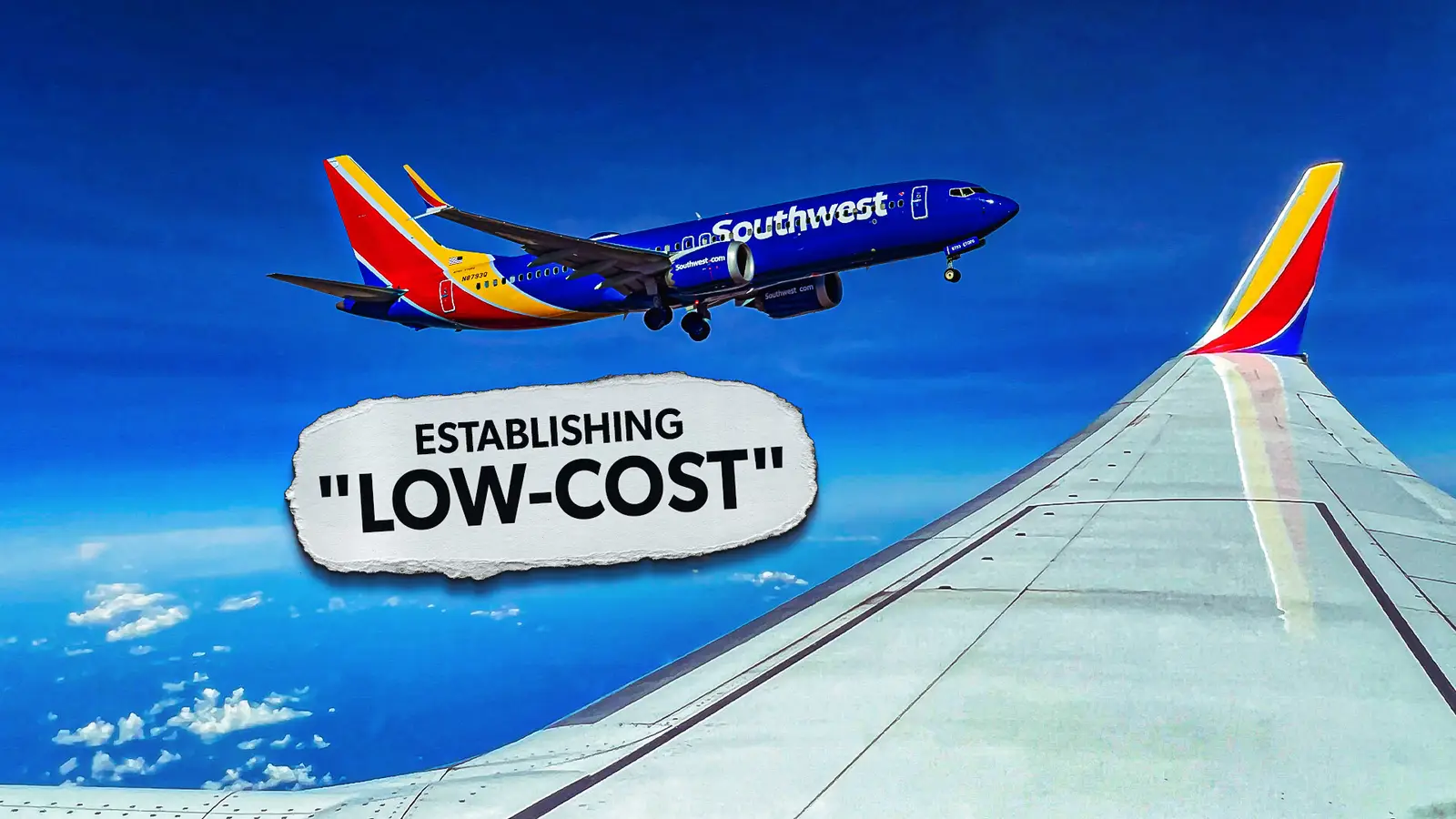How Southwest Airlines Broke The Legacy Carrier Model And Revolutionized The Way Americans Fly

Southwest Airlines (NYSE: LUV) is one of the most unique carriers to operate in the North American air travel market, and not just because of its high-profile interactions with activist investor Elliott Management. An airline focused almost entirely on connecting travelers with point-to-point flights that are looking for affordable service, Southwest Airlines differs from its principal full-service carriers in a few different ways. The legacy operator has been known for providing extra benefits such as free checked bags, although the airline’s strategy has fundamentally changed in recent years due to the influence that Elliott Management has recently had on the airline. Despite its recent strategic shifts, the airline has had a major impact on the way we fly in the United States today.
An airline with a fixed operational structure, Southwest has made every effort to lower its operating expenses, building out market niches in underserved destinations where its low-cost services are appealing. It continues to win when it can consistently offer a more affordable and more convenient service than competitors, especially when it comes to city pairs that lack nonstop flights. Born in Texas and eventually growing into a nationwide behemoth, Southwest’s operational structure today makes it one of the world’s largest and most influential low-cost airlines.
A Brief Overview Of Southwest Airlines
Southwest Airlines is a major US-based carrier headquartered at Dallas Love Field (DAL). The airline is best known for its single-fleet strategy, with an all-Boeing 737 fleet. The carrier operates flights to more than 100 destinations across 42 states, Washington, D.C., Puerto Rico, and additional nearby international markets in the Caribbean, Mexico, and Central America. In terms of passengers carried, it ranks as North America’s fourth-largest airline.
Founded on March 9, 1967, by Herb Kelleher and Rollin King originally as Air Southwest, the company adopted the Southwest Airlines name in 1971 and commenced operations entirely within the state of Texas, where it linked Dallas, Houston, and San Antonio. Following deregulation, the airline launched interstate services in 1979 and later expanded nationwide in the decades that followed. Southwest’s early success popularized its low-fare, high-utilization model with quick turns and high-frequency point-to-point services, according to a breakdown on the carrier from ResearchGate.
The airline’s product core has evolved over time, with today’s Southwest beginning to transition away from many of the features that used to be core elements of its brand. The airline operated a standardized Boeing 737 fleet, with dense scheduling on popular city pairs. It also has a large domestic footprint that is supplemented by extensive short-haul international services. This combination has made Southwest a dynamic competitor in the US aviation market and a staple player for leisure and value-oriented business travelers.
A Deeper Look At The History Of Southwest Airlines
Southwest Airlines began as Air Southwest Co., a company that was initially incorporated in 1978 with the intention of operating an intrastate Texas Triangle route, with services from Dallas to Houston and San Antonio, in order to avoid federal aviation controls on intrastate routes. After lawsuits from rivals were resolved in 1970, the airline rebranded as Southwest Airlines in 1971, and it expanded across Texas by 1975. Soon thereafter, the carrier pushed into adjacent states post-deregulation in 1979. The carrier’s eventual entry into markets on the East Coast took place in the 1990s, and the airline launched flights to Denver International Airport (DEN) in 2006, a route that soon became its busiest destination.
Southwest Airlines posted 47 straight years of profitability between 1973 and 2019, when several challenges harmed its profitability outlook. The pandemic-driven global slowdown and a 2022 holiday meltdown, which was ultimately blamed on severe weather and outdated scheduling, triggered more than 15,000 cancellations, including a record $104 million fine from the Department of Transportation. The carrier soon after incurred more than $1.1 billion in losses. Activist hedge fund Elliott Investment Management quickly bought more than 10% of shares, pushing governance and strategic shifts.
A settlement between the two parties in October 2024 saw a handful of Elliott-backed directors join Southwest’s board while former CEO Gary Kelly quickly exited as executive chairman. Under new oversight, Southwest Airlines quickly began layoffs, ended the two free checked bags policy on May 28, 2025, adopted an assigned seating policy, and began to add premium seating and increase basic fares. The airline introduced red-eye flights and limited flight-credit validity to just one year. For the first time, Southwest began to list fares on third-party sites and launched a codeshare agreement with Icelandair.
A Look At Southwest’s Fares And Network
The Southwest Airlines network runs point-to-point routes with rolling hubs located at base cities, which differ from traditional hub-and-spoke networks in a few key ways. Aircraft and crews flow continuously throughout the day, with higher turn frequencies than most airlines and a lack of dependence on a singular megahub. As of January 2025, the airline’s network has expanded to include more than 100 destinations all across North America (except for Canada). Some airports have more departures and spokes than others, but Southwest does not designate a formal hub.
Newer interline agreements extend the airline’s virtual reach beyond the Americas, linking itineraries with players like Icelandair, China Airlines, and EVA Air for connections all across Europe and Asia. The Southwest Airlines fleet has a single type, with the Boeing 737 being the backbone of the carrier’s operations. The carrier is the world’s largest Boeing 737 operator and the fifth-largest airline fleet globally. As of June 2025, the carrier flies more than 800 next-generation jets, with more than 500 additional 737 MAX jets on order.
Historically, the carrier has flown only Boeing 737 models aside from a brief period in the late 1970s and early 1980s when it operated a handful of Boeing 727-200s. This one-type approach helped the airline simplify pilot and crew qualification, scheduling, spare parts management, and maintenance, helping lower training times and overall unit costs. When combined with a point-to-point schedule, this uniform fleet helps underpin Southwest’s high-utilization model and dense frequency on popular city pairs.
What Makes Southwest Airlines So Unique?
To be fair to Southwest, the airline’s uniqueness goes far beyond the benefits that Elliott Management is making it get rid of. A carrier distinctive for its point-to-point network and system of rolling hubs, Southwest can avoid classic hub-and-spoke banks to keep jets moving and make sure frequencies remain dense.
Operating just a single-type fleet, the airline can simplify training, maintenance, and scheduling at scale. From a cultural perspective, Southwest was historically seen as a pioneer in the low-cost space, an airline that thrived on high-utilization operations and a casual service ethos, while building big city-pair presences as opposed to long-haul hubs.
This also extends the airline’s reach through interline links with carriers like Icelandair, China Airlines, and EVA Air. The airline today is reshaping its operating model, adding assigned seating, new fare tiers, and red-eye services. It is unclear if the Southwest Airlines of 2030 will look anything like the Southwest Airlines of early 2020.
How Did Southwest Change Aviation?
The Southwest Airlines business model fundamentally rewrote conventional airline economics with its single-type fleet, rapid aircraft turns, and point-to-point services, which would slash costs and fares. The Boeing 737-only strategy simplified training, maintenance, and scheduling efforts.
20-minute turnarounds would drive higher aircraft utilization. Targeting secondary airports and dense city pairs allowed the airline to expand short-haul travel and force legacy carriers to unbundle products and match low prices. The airline demonstrated that air travel was not just for the privileged few who could afford the sky-high fares of legacy airlines.
The airline’s introduction of customer-friendly policies did make it a favorite among travelers for a very long time. However, those days are likely over.
What Is The Bottom Line When It Comes To Southwest Airlines?
At the end of the day, Southwest Airlines is the kind of operator that is truly one-of-a-kind. Or, at least, it was. The airline is undergoing a period of radical transformation, which is dragging the once family-friendly airline away from its roots. Elliott’s moves will improve the airline’s prospects in the short-term, but the longer-term vision is undeniably less certain.
Over time, legacy operators have tried to cannibalize Southwest’s market share, dropping fares and adopting no-frills ticket packages that directly target the same kind of audience as the carrier. Now, the airline is undergoing rapid change with the intention of improving the company’s long-term earnings outlook.
However, while investors may be happy with the moves the company is looking to make in the short term, it is not exactly clear if passengers and employees feel the same way. Southwest’s decision to end the company’s long-standing commitment to not laying off any employees came to an end, and shifts in several policies have undoubtedly degraded how passengers feel about their overall experience.



